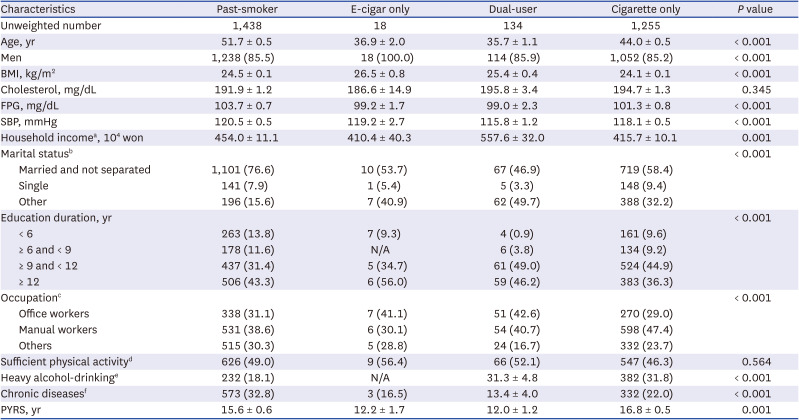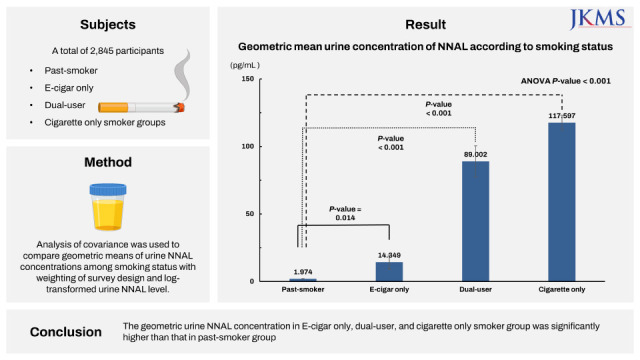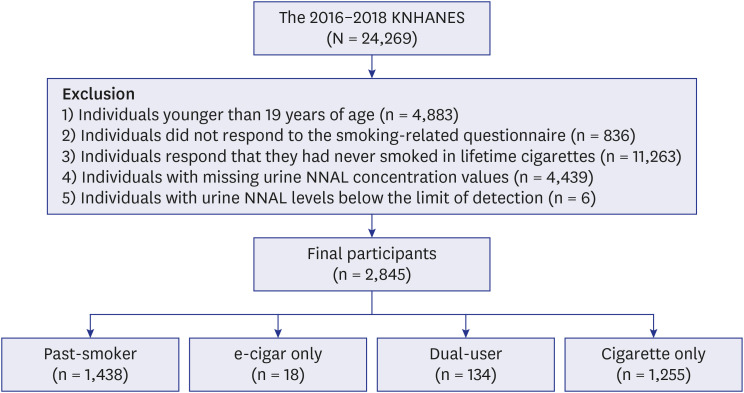1. Centers for Disease Control and Prevention, National Center for Chronic Disease Prevention and Health Promotion, Office on Smoking and Health. How Tobacco Smoke Causes Disease: The Biology and Behavioral Basis for Smoking-Attributable Disease: A Report of the Surgeon General. Atlanta, GA, USA: Centers for Disease Control and Prevention;2010.
2. Benowitz NL, Goniewicz ML. The regulatory challenge of electronic cigarettes. JAMA. 2013; 310(7):685–686. PMID:
23856948.
3. Coleman BN, Rostron B, Johnson SE, Ambrose BK, Pearson J, Stanton CA, et al. Electronic cigarette use among US adults in the Population Assessment of Tobacco and Health (PATH) study, 2013-2014. Tob Control. 2017; 26(e2):e117–e126. PMID:
28624763.
4. Kasza KA, Ambrose BK, Conway KP, Borek N, Taylor K, Goniewicz ML, et al. Tobacco-product use by adults and youths in the United States in 2013 and 2014. N Engl J Med. 2017; 376(4):342–353. PMID:
28121512.
5. Wagner KA, Flora JW, Melvin MS, Avery KC, Ballentine RM, Brown AP, et al. An evaluation of electronic cigarette formulations and aerosols for harmful and potentially harmful constituents (HPHCs) typically derived from combustion. Regul Toxicol Pharmacol. 2018; 95:153–160. PMID:
29567331.
6. Patel D, Davis KC, Cox S, Bradfield B, King BA, Shafer P, et al. Reasons for current E-cigarette use among U.S. adults. Prev Med. 2016; 93:14–20. PMID:
27612572.
7. Farsalinos KE, Polosa R. Safety evaluation and risk assessment of electronic cigarettes as tobacco cigarette substitutes: a systematic review. Ther Adv Drug Saf. 2014; 5(2):67–86. PMID:
25083263.
8. Margham J, McAdam K, Forster M, Liu C, Wright C, Mariner D, et al. Chemical composition of aerosol from an e-cigarette: a quantitative comparison with cigarette smoke. Chem Res Toxicol. 2016; 29(10):1662–1678. PMID:
27641760.
9. Goniewicz ML, Knysak J, Gawron M, Kosmider L, Sobczak A, Kurek J, et al. Levels of selected carcinogens and toxicants in vapour from electronic cigarettes. Tob Control. 2014; 23(2):133–139. PMID:
23467656.
10. IARC Working Group on the Evaluation of Carcinogenic Risks to Humans. Personal habits and indoor combustions. IARC Monogr Eval Carcinog Risks Hum. 2012; 100(Pt E):1–538.
11. Hecht SS, Carmella SG, Murphy SE, Akerkar S, Brunnemann KD, Hoffmann D. A tobacco-specific lung carcinogen in the urine of men exposed to cigarette smoke. N Engl J Med. 1993; 329(21):1543–1546. PMID:
8413477.
12. Carlson ES, Upadhyaya P, Villalta PW, Ma B, Hecht SS. Analysis and identification of 2'-deoxyadenosine-derived adducts in lung and liver DNA of F-344 rats treated with the tobacco-specific carcinogen 4-(methylnitrosamino)-1-(3-pyridyl)-1-butanone and enantiomers of its metabolite 4-(methylnitrosamino)-1-(3-pyridyl)-1-butanol. Chem Res Toxicol. 2018; 31(5):358–370. PMID:
29651838.
13. Hecht SS. Biochemistry, biology, and carcinogenicity of tobacco-specific N-nitrosamines. Chem Res Toxicol. 1998; 11(6):559–603. PMID:
9625726.
14. Hecht SS, Stepanov I, Carmella SG. Exposure and metabolic activation biomarkers of carcinogenic tobacco-specific nitrosamines. Acc Chem Res. 2016; 49(1):106–114. PMID:
26678241.
15. Kovi RC, Johnson CS, Balbo S, Hecht SS, O’Sullivan MG. Metastasis to the F344 rat pancreas from lung cancer induced by 4-(methylnitrosamino)-1-(3-pyridyl)-1-butanone and enantiomers of its metabolite 4-(methylnitrosamino)-1-(3-pyridyl)-1-butanol, constituents of tobacco products. Toxicol Pathol. 2018; 46(2):184–192. PMID:
29390940.
16. Kweon S, Kim Y, Jang MJ, Kim Y, Kim K, Choi S, et al. Data resource profile: the Korea National Health and Nutrition Examination Survey (KNHANES). Int J Epidemiol. 2014; 43(1):69–77. PMID:
24585853.
17. Kim Y. The Korea National Health and Nutrition Examination Survey (KNHANES): current status and challenges. Epidemiol Health. 2014; 36:e2014002. PMID:
24839580.
18. Chang Y, Kang HY, Lim D, Cho HJ, Khang YH. Long-term trends in smoking prevalence and its socioeconomic inequalities in Korea, 1992-2016. Int J Equity Health. 2019; 18(1):148. PMID:
31533732.
19. Lee JG, Kim HC, Choi CM. Recent trends of lung cancer in Korea. Tuberc Respir Dis (Seoul). 2021; 84(2):89–95. PMID:
33587838.
20. Kang MJ, Won YJ, Lee JJ, Jung KW, Kim HJ, Kong HJ, et al. Cancer statistics in Korea: incidence, mortality, survival, and prevalence in 2019. Cancer Res Treat. 2022; 54(2):330–344. PMID:
35313102.
21. Bondurant S, Wallace R, Shetty P, Stratton K. Clearing the Smoke: Assessing the Science Base for Tobacco Harm Reduction. Washington, D.C., USA: National Academies Press;2001.
22. United States Public Health Service, Office of the Surgeon General. The Health Consequences of Involuntary Exposure to Tobacco Smoke: A Report of the Surgeon General. Washington, D.C., USA: U.S. Department of Health and Human Services, Office on Smoking and Health;2006.
23. Bernert JT, Pirkle JL, Xia Y, Jain RB, Ashley DL, Sampson EJ. Urine concentrations of a tobacco-specific nitrosamine carcinogen in the U.S. population from secondhand smoke exposure. Cancer Epidemiol Biomarkers Prev. 2010; 19(11):2969–2977. PMID:
20833972.
24. Hoffmann D, Hoffmann I, El-Bayoumy K. The less harmful cigarette: a controversial issue. a tribute to Ernst L. Wynder. Chem Res Toxicol. 2001; 14(7):767–790. PMID:
11453723.
25. Hoffmann D, Hecht SS. Advances in tobacco carcinogenesis. Cooper CS, Grover PL, editors. Chemical Carcinogenesis and Mutagenesis I. New York, NY, USA: Springer;1990. p. 63–102.
26. Hecht SS. Human urinary carcinogen metabolites: biomarkers for investigating tobacco and cancer. Carcinogenesis. 2002; 23(6):907–922. PMID:
12082012.
27. Akopyan G, Bonavida B. Understanding tobacco smoke carcinogen NNK and lung tumorigenesis. Int J Oncol. 2006; 29(4):745–752. PMID:
16964372.
28. Gaur S, Agnihotri R. Health effects of trace metals in electronic cigarette aerosols-a systematic review. Biol Trace Elem Res. 2019; 188(2):295–315. PMID:
29974385.
29. Goniewicz ML, Knysak J, Gawron M, Kosmider L, Sobczak A, Kurek J, et al. Levels of selected carcinogens and toxicants in vapour from electronic cigarettes. Tob Control. 2014; 23(2):133–139. PMID:
23467656.
30. Williams M, Villarreal A, Bozhilov K, Lin S, Talbot P. Metal and silicate particles including nanoparticles are present in electronic cigarette cartomizer fluid and aerosol. PLoS One. 2013; 8(3):e57987. PMID:
23526962.
31. Farsalinos KE, Voudris V, Poulas K. Are metals emitted from electronic cigarettes a reason for health concern? A risk-assessment analysis of currently available literature. Int J Environ Res Public Health. 2015; 12(5):5215–5232. PMID:
25988311.
32. Kiernan E, Click ES, Melstrom P, Evans ME, Layer MR, Weissman DN, et al. A brief overview of the national outbreak of e-cigarette, or vaping, product use-associated lung injury and the primary causes. Chest. 2021; 159(1):426–431. PMID:
32758560.
34. Kang HS, Kim JY, Park HJ, Jung JW, Choi HS, Park JS, et al. E-cigarette-associated severe pneumonia in Korea using data linkage between the Korea National Health and Nutrition Examination Survey (KNHANES, 2013-2019) and the National Health Insurance Service (NHIS) claims database. J Korean Med Sci. 2021; 36(48):e331. PMID:
34904409.
35. You HS, Lee JW, Kim YS, Kim Y, Lee HC, Hwang JY, et al. Association between second-hand smoke exposure and urinary NNAL level in Korean adolescents. J Korean Med Sci. 2021; 36(13):e82. PMID:
33821591.







 PDF
PDF Citation
Citation Print
Print





 XML Download
XML Download